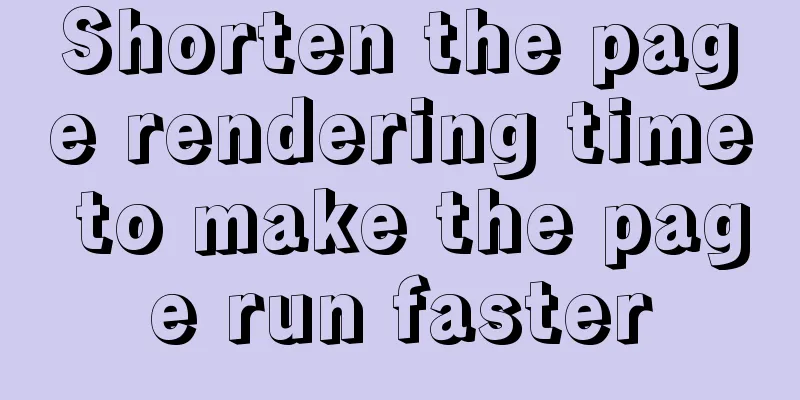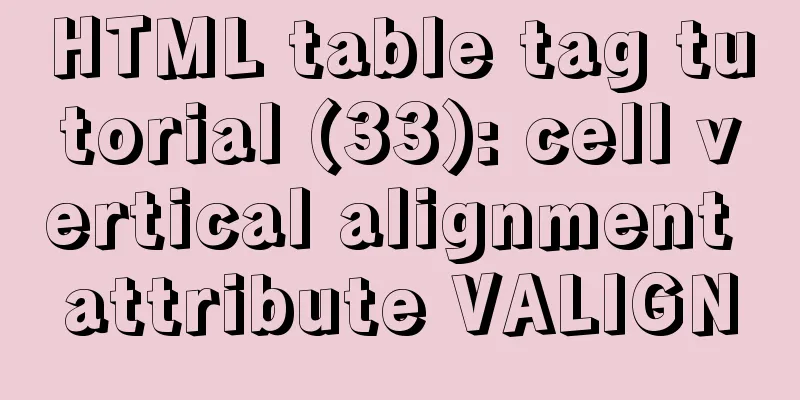Shorten the page rendering time to make the page run faster

|
How to shorten the page rendering time on the browser as much as possible? This article starts from the following aspects:
1. Write efficient CSS code First, understand the process of browser parsing HTML code: build a DOM tree, and each element to be displayed on the page will be created in this DOM tree. Whenever a new element is added to the DOM tree, the browser will search the CSS style sheet through the CSS engine, find the style rules that match the element and apply them to the element. The CSS engine searches the style sheet and matches each rule from right to left. After understanding the process, we can see that we can optimize our CSS code from two aspects: 1. The fewer CSS style rules defined, the better, so quickly delete unnecessary style definitions in the CSS file; 2. Optimize the selector writing method of each rule, and try to let the CSS engine know at a glance whether this rule needs to be applied to the current element, so that the engine can avoid unnecessary detours. For example, the following are some inefficient ways of writing CSS: a, Use wildcards as key selectors (key selectors refer to the rightmost selectors of each rule) Copy code The code is as follows:body * {...} .hide-scrollbars * {...} b. Use labels as key selectors Copy code The code is as follows:ul li a {...} #footer h3 {...} * html #atticPromo ul li a {...} c, superfluous writing Copy code The code is as follows:ul#top_blue_nav {...} form#UserLogin {...} d. Add the :hover pseudo-class to non-link tags. This will make pages with strict doctype very slow in IE7 and IE8. Copy code The code is as follows:h3:hover {...} .foo:hover {...} #foo:hover {...} div.faa :hover {...} Optimization suggestions: Copy code The code is as follows:/*Define different colors for unordered and ordered li, you might write: */ ul li {color: blue;} ol li {color: red;} /*Add class to li, so the definition efficiency will be higher: */ .unordered-list-item {color: blue;} .ordered-list-item {color: red;} e. Avoid adding the :hover pseudo-class to non-connected tags. Second, avoid using CSS expressions CSS expressions only work in IE browsers. Microsoft has not recommended their use since IE8 because they can seriously affect page performance: at any time, no matter what event is triggered, such as window resize events, mouse movement, etc., the CSS expression will be recalculated. 3. Put the CSS file at the top of the page Placing external or inline style sheets in the body section will affect the speed of page rendering, because the browser will not continue downloading the rest of the page until all style sheets have been downloaded. In addition, inline style sheets (styles placed in <style>) may cause the page to be re-rendered or display certain elements in hidden pages. It is recommended not to use inline style sheets. Fourth, specify the size of the page image Specifying the page image size should match the actual size of the image (do not scale the image by specifying the size). This can avoid changes in the page structure caused by size changes, so it is beneficial to speed up page rendering. 5. Indicate the document code in the page header HTML documents are transmitted across the network in the form of a data stream containing document encoding information. The encoding information of the page is generally specified in the header information of the HTTP response or in the HTML tag within the document. The client browser can only render the page correctly after determining the page encoding. Therefore, before drawing the page or executing any JavaScript code, most browsers (except IE6, IE7, and IE8) will buffer a certain number of bytes of data to find the encoding information. The number of bytes pre-buffered in different browsers is different. If the browser has not found the encoding information of the page after receiving the set amount of pre-buffered data, it will start rendering the page according to its own specified default encoding. If the page encoding information is obtained at this time and it is inconsistent with the current encoding, the entire page will have to be re-rendered, and in some cases it will even be necessary to re-acquire the data. Therefore, for pages larger than 1KB in size (according to tests on various browsers, the maximum amount of pre-buffered data is 1KB), the encoding information should be marked as early as possible. Optimization suggestions: Note: The article is not completely translated according to the original meaning of the Google document. The translated text is expressed in combination with my own understanding. If you find any errors, thank you for correcting them. |
<<: Form submission page refresh does not jump
>>: MySQL deep paging (how to quickly paginate tens of millions of data)
Recommend
ElementUI implements the el-form form reset function button
Table of contents Business scenario: Effect demon...
How to insert a value containing single quotes or backslashes in MySQL statements
Preface This article mainly introduces the releva...
How to use TypeScript in Vue
introduction In recent years, the call for TypeSc...
Pure CSS3 to create page switching effect example code
The one I wrote before is too complicated, let’s ...
Detailed explanation of the principles and usage of MySQL master-slave replication and read-write separation
This article uses examples to illustrate the prin...
uni-app implements NFC reading function
This article shares the specific code of uni-app ...
Use and optimization of MySQL COUNT function
Table of contents What does the COUNT function do...
The implementation process of extracting oracle data to mysql database
In the migration of Oracle database to MySQL data...
Detailed explanation of KVM deployment of three virtual machines to implement WordPress experiment
1. Introduction to KVM The abbreviation of kernel...
Detailed explanation of the basic usage of the auxiliary function mapGetters in vuex
mapGetters Helper Function mapGetters helper func...
Network configuration of Host Only+NAT mode under VirtualBox
The network configuration of Host Only+NAT mode u...
Tutorial on using hyperlink tags in XHTML
Hyperlink, also called "link". Hyperlin...
Example code for implementing equal height layout in multiple ways with CSS
The equal height layout described in this article...
Detailed explanation of the application and difference between filter attribute and backdrop-filter in CSS
There are some differences between filter and bac...
Tomcat parses XML and creates objects through reflection
The following example code introduces the princip...









